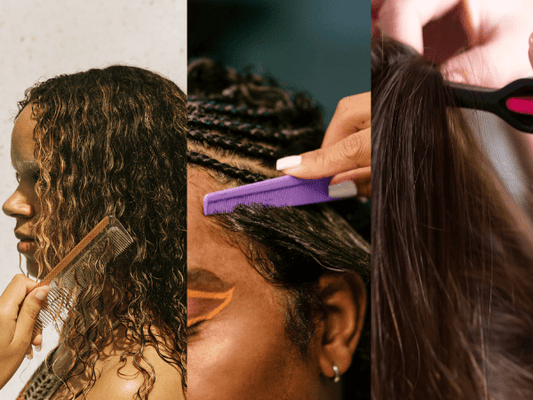Take Our Curl Type Quiz
The Curly Hair Spectrum
Curly hair is often categorized using a system that ranges from type 2 (wavy) to type 4 (coily), with subcategories within each type based on the tightness of the curl or coil. This classification helps in identifying your specific hair type and tailoring your hair care routine accordingly.
Type 2: Wavy Hair
- Type 2A: Fine, thin, and easy to handle, type 2A waves are soft and subtle with a slight "S" pattern.
- Type 2B: These waves are medium in thickness, with a more defined "S" pattern that starts at the mid-length of the hair.
- Type 2C: The thickest and most defined of the wavy types, 2C waves are prone to frizz and have a stronger "S" pattern.
Managing Wavy Hair: The key to managing wavy hair is to enhance the natural wave without weighing it down. Lightweight mousses or gels can define waves without causing stiffness. Avoid heavy creams or oils that can flatten the hair. Regular trims can prevent the ends from appearing stringy.
Type 3: Curly Hair
- Type 3A: Curls are large and loose, with a circumference similar to sidewalk chalk. These curls tend to be shiny and voluminous.
- Type 3B: Medium-sized curls with the circumference of a marker, type 3B hair is denser and may have a combination of textures.
- Type 3C: Tight curls or coils that resemble corkscrews, type 3C has the most volume and can be prone to dryness.
Managing Curly Hair: Moisture is crucial for type 3 hair. Deep conditioning treatments and hydrating products can help maintain the health of the curls. Use a wide-tooth comb or fingers to detangle gently. Styling creams and gels can define curls and control frizz. Protecting the hair at night with a satin or silk pillowcase can preserve curl patterns and minimize breakage.
Type 4: Coily Hair
- Type 4A: Coils are tightly coiled with an "S" pattern, similar in circumference to a crochet needle. They are well-defined and springy.
- Type 4B: Coils are less defined, with a "Z" pattern and a cotton-like feel. The hair can be very dense and shrinks significantly when dry.
- Type 4C: The tightest coil, 4C hair, has a "Z" pattern that is so tight that the curls may not be visible. This type is the most fragile and requires gentle handling.
Managing Coily Hair: Coily hair needs plenty of moisture and protection. Heavy creams, butters, and oils (like castor and coconut oil) can provide the necessary hydration. Detangle hair when wet and with a conditioner to minimize breakage. Protective styles such as twists and braids can prevent tangles and retain length. Regular deep conditioning and protein treatments can strengthen the hair and promote elasticity.
General Tips for All Curly Hair Types
- Avoid Sulfates and Silicones: Sulfates can strip the hair of natural oils, while silicones can build up and weigh down curls. Opt for sulfate-free shampoos and silicone-free conditioners.
- Limit Heat Styling: Heat can damage the hair's cuticle, leading to dryness and frizz. When using heat, always apply a heat protectant.
- Trim Regularly: Regular trims can prevent split ends from traveling up the hair shaft, which can cause more damage.
- Use a Microfiber Towel or T-Shirt to Dry: Traditional towels can create friction and frizz. Gently squeeze out water with a microfiber towel or a soft T-shirt.
- Deep Condition Regularly: Incorporating regular deep conditioning treatments into your routine can restore and maintain moisture levels in your hair.
Conclusion
Understanding your curly hair type is the first step towards embracing and caring for your natural curls. Each type requires a tailored approach to ensure it remains hydrated, healthy, and vibrant. By incorporating the right products and practices into your hair care routine, you can enhance your curls' natural beauty and texture. Remember, the goal isn't to alter your curls but to nurture and celebrate them in their natural state. With patience and proper care, you can unlock











